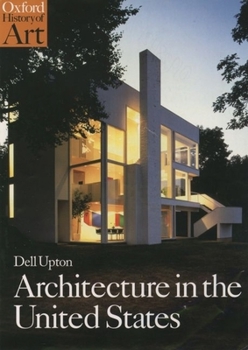Architecture in the United States
Select Format
Select Condition 
Book Overview
American architecture is astonishingly varied. From Native American sites in New Mexico and Arizona, and the ancient earthworks of the Mississippi Valley, to the most fashionable contemporary buildings of Chicago and New York, the United States boasts three thousand years of architectural history. It is characterized by the diversity of its builders and consumers who include Native American men and women, African, Asian, and European immigrants, as well as renowned professional architects and urban planners.
Leading historian Dell Upton's revolutionizing interpretation examines American architecture in relation to five themes: community, nature, technology, money, and art. In giving particular attention to indigenous, folk, ethnic, and popular architectures like Chaco Canyon, the Brooklyn Bridge, and Native American houses, as well as to the great monuments of traditional histories such as Jefferson's Monticello and Wright's Fallingwater, Architecture in the United States reveals the dazzling richness of America's human landscape.
Leading historian Dell Upton's revolutionizing interpretation examines American architecture in relation to five themes: community, nature, technology, money, and art. In giving particular attention to indigenous, folk, ethnic, and popular architectures like Chaco Canyon, the Brooklyn Bridge, and Native American houses, as well as to the great monuments of traditional histories such as Jefferson's Monticello and Wright's Fallingwater, Architecture in the United States reveals the dazzling richness of America's human landscape.
Format:Paperback
Language:English
ISBN:019284217X
ISBN13:9780192842176
Release Date:June 1998
Publisher:Oxford University Press
Length:336 Pages
Weight:1.76 lbs.
Dimensions:0.8" x 6.6" x 9.3"
Related Subjects
Architecture Art Art History Arts, Music & Photography History History & Criticism Humanities ReferenceCustomer Reviews
1 rating
A New Look at American Buildings and Americans
Published by Thriftbooks.com User , 25 years ago
This book will be a classic. It is not so much a history of American architecture as it is a sociology, and not so much a sociology as it is a subtle and invigorating study of the social relations and social dynamics of American buildings and the people who make and use them. The book's views can be startling---see the comments on Jefferson's Monticello, on Buckminster Fuller, on Richard Meier's Getty Center in Los Angeles. It is beautifully written and the photographs are often dazzling. It even tackles the American suburb and shopping malls. Its views of the development of architecture as a profession and the status of architecture in the history of art are provocative and incisive. Highly recommended.





